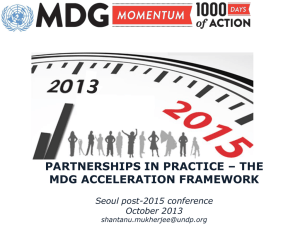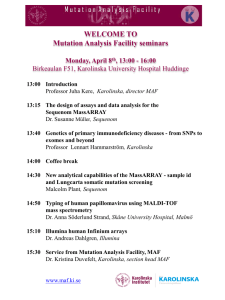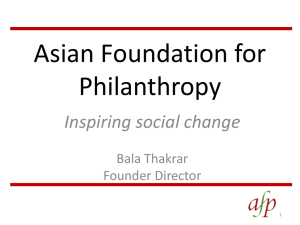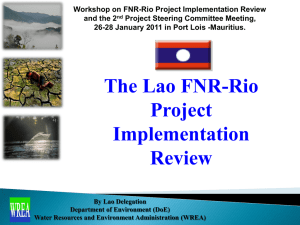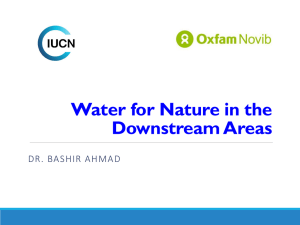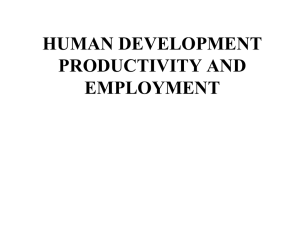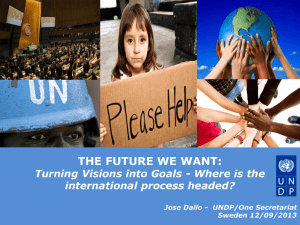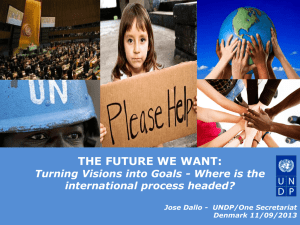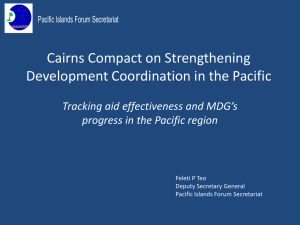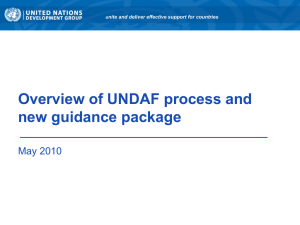Slide 0 - National Planning Commission
advertisement
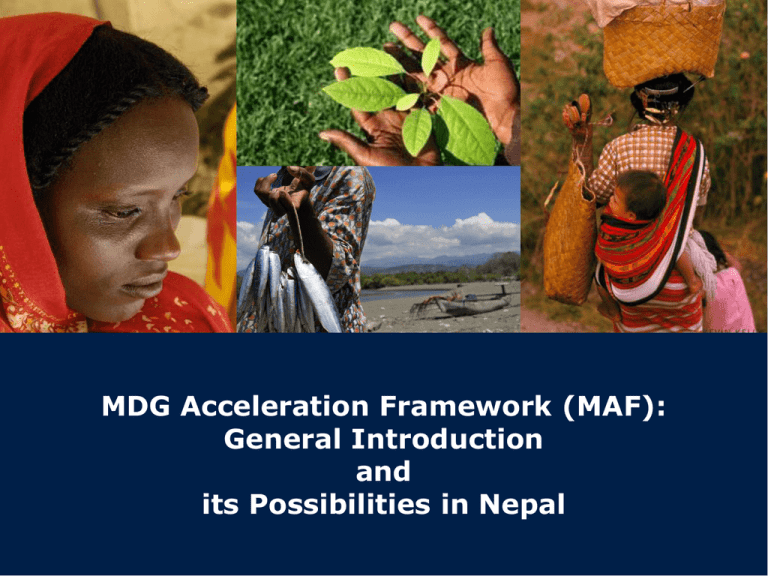
MDG Acceleration Framework (MAF): General Introduction and its Possibilities in Nepal 0 © United Nations Development Programme | THE MAF: A SHORT HISTORY ▪ The 2010 MDG Summit – Countries know what needs to be done to achieve the MDGs, but progress in implementation is lacking or has slowed in many sectors. – Outcome document calls for an acceleration agenda for the MDGs ▪ MAF developed and tested over 2009-2010 – 14 countries and six MDGs – UNDG MDG Task Force ▪ MAF formally endorsed in 2010 by UNDG – UN Secretary-General Ban Ki-moon and UNDG Chair Helen Clark introduce it at the 2010 Summit – UNDP corporate priority – UNDG guidance to UNCTs ▪ Unlocking Progress: MDG Acceleration on the road to 2015 – Summarize and synthesize main lessons learned from the pilot phase – Growing body of country reports and experiences | 1 © United Nations Development Programme WHAT IS ACCELERATION? Achievement of intermediate targets 100% Target 80% 60% Historical trend 40% High Trajectory (solution has immediate impact) 20% Low Trajectory (solution has low impact) Starting point 0% 2000 2005 2010 2015 2 | WHAT IS THE MDG ACCELERATION FRAMEWORK? Responding to national/local political determination to tackle identified off-track MDGs Drawing upon country experiences and ongoing processes to identify and prioritize bottlenecks interfering with the implementation of key MDG interventions Using knowledge-based good practices to determine objective and feasible solutions for accelerating MDG progress Creating a partnership with identified roles for all relevant stakeholders to jointly achieve MDG progress 3 | SYSTEMATIC STEPS IN THE MAF Identify, codify the interventions required to meet the MDG targets Identify solutions to form an MDG Country Action Plan that aligns and focuses stakeholders and resources on accelerating MDG progress Implement and Monitor the MDG Country Action Plan to ensure required impact Help identify and prioritize MDG bottlenecks | FINDING AND PRIORITIZING BOTTLENECKS | 5 © United Nations Development Programme WORK IN PROGRESS: MAF ROLLOUTS TO DATE | Nepalese Prospective towards MAF Relating to Off Track MDG Targets • Proportion of population below minimum level of dietary energy consumption, • Proportion of underweight children 6–59 months, • Proportion of stunted children 6–59 months, • Survival rate to grade 5, • Literacy rate for 15–24 year olds, • Proportion of births attended by skilled birth attendant, • Proportion of population using an improved sanitation facility. 7 | LEADERSHIP & PARTNERSHIPS: CENTRAL IN MAFs • MAF process owned by the Government • The Resident Coordinator (RC) has a crucial role in initiating, facilitating and following up • All stakeholders who can contribute to accelerating progress should be partners – Government (across ministries and national/sub-national levels), UN funds and agencies (including UNCT), donors, civil society, academia/think tanks and the private sector • Important to involve civil society: Reputed CSOs provide crucial inputs for the analysis, help validate results and secure buy-in, are potential partners in the implementation and monitoring of the Action Plan. 8 | GOING BEYOND THE NATIONAL: COLOMBIA National aggregates mask disparities by region and community Addressing inequalities can be key for success; and politically critical Local governments, CSOs, academia, and private sector often valuable partners In both LDCs and MICs, overcoming serious inequalities is a challenge, and an opportunity – Colombia wishes to reduce social divisions. Activities customized by levels where inequalities are most evident. Provincial and municipal MAFs target different MDGs – health, gender, poverty. Such MAFs exploit degree of decentralization, while integrating with national/regional plans. 9 | LESSONS ADDED VALUE Government ownership and coordination Prioritizing within current investment plans: Togo Expert MAF team – national and external – for quality and coherence Motivating cross-ministerial collaboration: Uganda Cross-sectoral and crossministerial engagement: UNCT involvement: UNDG endorsement Highlighting local solutions: Uganda Bringing together different partners and stand-alone activities: Ghana, Tajikistan Anchoring in existing plans Helping implement laws, roadmaps and policies: Tanzania Participation of local governments, CSOs and NGOs Indicating how best to adapt existing tools: PNG Learning – but not duplicating – across countries Using available data Addressing inequalities: Colombia Attracting partner interest: Ghana, Niger, Belize… | 10 FOLLOWING THROUGH WITH IMPLEMENTATION Country Actions: Identified neglected policy areas-Uganda addressed women’s right to reproductive health choices Forged new partnerships- Colombia’s provincial governments partnered with the private sector for job creation among vulnerable groups Mobilized Resources- EU MDG Fund to support MAF Action Plans; and Niger’s allocation of budgetary resources ($30 million) to implementation Strengthened advocacy- Ghana declared ‘national emergency on maternal mortality’ and successfully brought new partners on board UNDP/UNDG Actions: Cross-practice effort to help country offices support implementation; dedicated Democratic Governance TTF (2011) to help remove governance and capacity bottlenecks (e.g. Belize’s water board) Encouraging regional and global collaboration with development partners (MDG Summit follow up conference in Tokyo; EU and others) Incorporating into UNDAF Action Plan: Tanzania (DaO) and Lao PDR; MAF at Regional UNDAF Trainings 11 | IS THE MAF FOR YOU? MDG priorities established with national political commitment to tackle off-track targets Criteria for assessing the MAF value added Special country context facilitating engagement of all actors and implementation of the MAF Action Plan Evidence of what works and what doesn’t – at national and sub-national levels - drawing from MDG-based NDS’s/PRSPs, mid-term reviews and others Possibility of linking to PRSP/NDP consultations and preparation, as well as to the CCA analysis and UNDAF UNCT capable of influencing policy space in the country, and a strong and respected partner of the Government 12 | NEXT STEPS FOR REACHING THE MDGs Extending the MAF to countries where there is a recognized value added Implementing the Action Plans Achieving and sustaining results and sharing the lessons 13 | MAF AVAILABLE RESOURCES MDG Acceleration Framework http://www.undg.org/index.cfm?P=15 05 MAF Operational Note and Annexes MAF Brochure http://www.tg.undp.org/undptogo/d ownload/Rapports/MAF%20201009%20OK.pdf Lao PDR: Reaching the unreached http://www.undg.org/index.cfm?P=15 05 http://www.undplao.org/newsroom/ publication/MAF%20Report_Lao%20 PDR_September%202010.pdf Unlocking progress Report on MAF pilot roll-outs Colombia: Sub-national levels Nariño: Empowering women http://content.undp.org/go/cmsservice/download/asset?asset_id=284 4466 http://www.odm.pnudcolombia.org/ pdf/NARINO_UK%20v4.pdf 14 | MAF AVAILABLE RESOURCES Colombia: Sub-national levels Cundinamarca: Poverty reduction Togo: MAF on rural poverty (Hard copy only for now) http://www.odm.pnudcolombia.org/ pdf/cundinamarca_v4.pdf Colombia: Sub-national levels Santander: Maternal health http://odm.pnudcolombia.org/pdf/ maf_col_san_en.pdf Ghana: MAF on maternal health http://www.undpgha.org/docs/MAFGhana_MDG5_Lo w_Web.pdf Uganda: MAF on maternal health Belize: Water and Sanitation http://www.finance.go.ug/docs/Ugan da%20MDG%20report%202010_final. pdf (Hard copy only for now) 15 | Thank You shantanu.mukherjee@undp.org 16 © United Nations Development Programme
